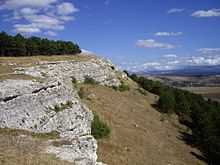Cuesta


In general usage, a cuesta is a hill or ridge with a gentle, less than 5°, slope on one side, its backslope, and a steep slope, its frontslope, on the other. In geology and geomorphology, cuesta refers specifically to an asymmetric ridge with a long and gentle backslope, called a dip slope, that conforms with the dip of a resistant stratum or strata, called caprock, that form it and a steeper or even cliff-like frontslope (escarpment) that is formed by the outcrop of the caprock. The escarpment cuts through the dipping strata that comprises the cuesta. The term cuesta is derived from (from Spanish: "flank or slope of a hill; hill, mount, sloping ground").[1][2][3]
Cuestas are the expression of extensive outcrops of gently dipping strata, typically sedimentary strata, that consist of alternating beds of weak or loosely cemented strata, i.e. shale, mudstone, and marl and hard, well-lithified strata, i.e. sandstone and limestone. The surface of hard, erosion-resistant rock strata forms the caprock of the backslope (dip-slope) of the cuesta where erosion has preferentially removed the weaker strata. The opposite slope, its frontslope, that forms the front of a cuesta consists of an escarpment that cuts across the bedding of the strata comprising it. Because of the gently dipping nature of the strata that forms a cuesta, a significant shift in horizontal location will take place the landscape is lowered by erosion.[1][2][4][5] Because the slope of a cuesta dips in the same direction as the sedimentary strata, the dip angle of this bedding (Ө) can be calculated by v/h= tan(Ө) where v is equal to the vertical distance and h is equal to the horizontal distance perpendicular to the strike of the beds.[6]
Cuestas, homoclinal ridges, and hogbacks comprise a sequence of landforms that form a gradational continuum. These landform differ only on the steepness of their backslopes and relative differences in the inclination of their backslopes and frontslopes. These differences depends upon whether the dip of the strata from they have been eroded are either nearly vertical, moderately dipping, or gently dipping. Because of their gradational nature, the exact angle of the backslope that separates these landforms is arbitrary and some differences in the specific angles used to define these landforms occur in the scientific literature. In addition, it also can be difficult to distinguish sharply immediately adjacent members of this series of landforms because of their gradational nature.[2][4][5][7]
Examples of cuestas
Two well-known cuestas in western New York and southern Ontario are the Onondaga escarpment and the Niagara escarpment, respectively. The dip of the Onondaga is about 40 feet per mile (about 7.6 m/km) to the south. The escarpment edge faces north and, in its most populated section, runs roughly parallel to the southern Lake Ontario shoreline.
The Gulf Coastal Plain in Texas is punctuated by a series of cuestas that parallel the coast, as are most coastal plains.[8] The Reynosa Plateau is the most coast-ward cuesta, which sees surface expression with the Bordes-Oakville escarpment, on the northwest side and a low ridge on the eastern boundary, called the Reynosa cuesta, where the deposits dip below later Pliocene-Pleistocene deposits of the Willis and Lissie Formation.
Cuestas have less dramatic expression in the United Kingdom, with two notable examples being the northwest-facing escarpment of the Jurassic chalk White Horse Hills and the similarly-aligned escarpment of the Cotswolds, sometimes called the Cotswold Edge.
In continental Europe, the Swabian Alb offers particularly good views of cuestas in Jurassic rock. In France, the term for a cuesta is the same as for a coastline: "côte". Notable French cuestas are the wine-growing regions of Côte d'Or and Côtes du Rhône.
See also
| Wikimedia Commons has media related to Cuesta. |
References
- ↑ 1.0 1.1 Cotton, CA (1952) Geomorphology An Introduction to the Study of Landforms. John Wiley and Sons, New York. 505 pp.
- ↑ 2.0 2.1 2.2 Simonett, SD (1968) Cuesta. In RW Fairbridge, ed., pp. 233, The Encyclopedia of Geomorphology (Encyclopedia of Earth Sciences, Volume III), Reinhold, New York, 1296 pp. ISBN 978-0879331795
- ↑ Jackson, JA, J Mehl and K Neuendorf (2005) Glossary of Geology. American Geological Institute, Alexandria, Virginia. 800 pp. ISBN 0-922152-76-4
- ↑ 4.0 4.1 Thornbury, W. D., 1954, "Principles of Geomorphology New York, John Wiley & Sons, 618 pp.
- ↑ 5.0 5.1 Twidale, CR, and EM Campbell (1993) Australian Landforms: Structure, Process and Time. Gleneagles Publishing, Adelaide, South Australia, Australia. 568 pp. ISBN 13: 9781875553020
- ↑ Easterbrook, DJ (1999) Surface Processes and Landforms, 2nd ed. Prentice-Hall, Inc, Upper Saddle River, New Jersey.
- ↑ Fairbridge, RW (1968) Hogback and Flatiron. In RW Fairbridge, ed., pp. 524-525, The Encyclopedia of Geomorphology (Encyclopedia of Earth Sciences, Volume III), Reinhold, New York, 1296 pp. ISBN 978-0879331795
- ↑ Strahler, AN (1960) Physical Geography, 2nd ed. John Wiley & Sons, Inc, New York, New York